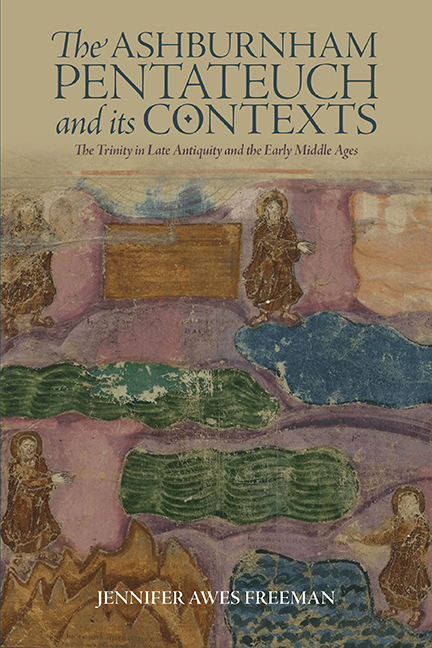Book contents
- Frontmatter
- Dedication
- Contents
- List of Illustrations
- List of Abbreviations
- Introduction: Losing and Finding the Ashburnham Pentateuch
- 1 Early Trinitarian Texts and Debates
- 2 The Trinity in Early Christian Images
- 3 Carolingian Conceptions of the Trinity
- 4 Carolingian Image Theory
- 5 The Carolingian Reception of the Ashburnham Pentateuch
- Conclusion: Possible Motivations for the Ashburnham Pentateuch Erasures
- Coda: The Afterlives of the Ashburnham Pentateuch
- Acknowledgments
- Bibliography
- Index
- ALREADY PUBLISHED
4 - Carolingian Image Theory
Published online by Cambridge University Press: 26 May 2022
- Frontmatter
- Dedication
- Contents
- List of Illustrations
- List of Abbreviations
- Introduction: Losing and Finding the Ashburnham Pentateuch
- 1 Early Trinitarian Texts and Debates
- 2 The Trinity in Early Christian Images
- 3 Carolingian Conceptions of the Trinity
- 4 Carolingian Image Theory
- 5 The Carolingian Reception of the Ashburnham Pentateuch
- Conclusion: Possible Motivations for the Ashburnham Pentateuch Erasures
- Coda: The Afterlives of the Ashburnham Pentateuch
- Acknowledgments
- Bibliography
- Index
- ALREADY PUBLISHED
Summary
Carolingian Trinitarian theology, in the form of Genesis commentaries and responses to contemporary theological debates, reflected a desire to assert the indivisible unity of the Trinity, as well as that of the human and divine natures of Jesus. The commentaries on Genesis explicitly describe the act of Creation as a cooperative and incorporeal act of all three persons of the Trinity. We will now draw a more concrete connection between Carolingian theology and the erasures of the Ashburnham Pentateuch’s Creation page by examining a unique work of Carolingian theology that addresses representational art. After a discussion of the Opus Caroli Regis contra Synodum (OCR), which is novel as the only extant Carolingian text that deals extensively with the nature of the artistic image, this chapter will then consider a small group of images commissioned by the OCR's author, Theodulf of Orléans. The image theory, perhaps more appropriately termed “theology of the image,” that is articulated in the OCR contributes to understanding the erasures of the Ashburnham Pentateuch’s Creation page by providing a window into coeval expectations and standards of religious images.
THE OPUS CAROLI REGIS CONTRA SYNODUM ON IMAGES
Around the year 790, Charlemagne commissioned Theodulf of Orléans (c.750/60–821) to compose a detailed response to the Second Council of Nicaea (787), which had attempted to unite the church by condemning the Council of Hiereia (754) and had effectively ended iconoclasm in the East through its official affirmation of images and relics in private and public devotion. In broad strokes, the iconoclast position was driven by the Mosaic prohibition, the Monophysite and dualist tendencies, the desire to convert Jews and Muslims (who were viewed as aniconic), as well as what may have been a genuine reaction against the perceived novelty of the veneration of the image. Conversely, the iconodule, or pro-image, position asserted that not only are icons not idols but they are, in fact, essential testimonies of the incarnation. For example, this was articulated in several ways by Theodore the Studite in On the Holy Icons, who contended that, “if He is seen, He is circumscribed. Everything which is subject to vision must also be subject to circumscription.”
- Type
- Chapter
- Information
- The Ashburnham Pentateuch and its ContextsThe Trinity in Late Antiquity and the Early Middle Ages, pp. 118 - 146Publisher: Boydell & BrewerPrint publication year: 2022



